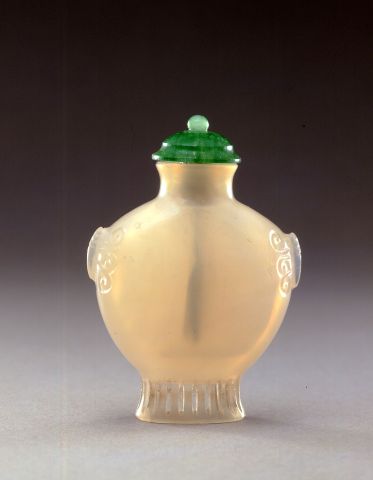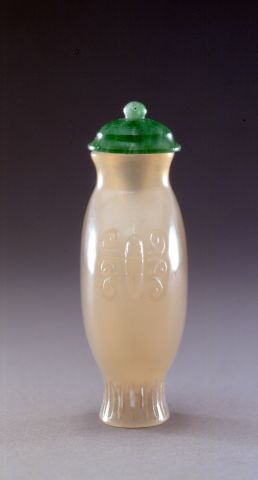

Bottle ID: 420
FLAWLESS PIERCED FOOT RIM
Date: 1750-1820
Height: 44 mm
Chalcedony, very well hollowed, of pale gray tones, of flattened tapering shield shape, with rounded shoulders sloping to an everted mouth, and with a deep oval footrim pierced with vertical holes, the sides carved with formalized butterfly handles.
Imperial, attributed to the Palace Workshops, Beijing.
Similar Examples:
Sotheby's Hong Kong, May 3, 1995, lot 437, the Cussons Collection.
Holden, Rachelle R. Rivers and Mountains Far From the World - The Rachelle R. Holden Collection, 1994, pp. 38-39, no. 8.
Moss, Hugh M. Chinese Snuff Bottles of the Silica or Quartz Group, 1971, p. 74, no. 196.
Moss, Hugh, Victor Graham and Ka Bo Tsang. A Treasury of Chinese Snuff Bottles - The Mary and George Bloch Collection, 2008, Vol. 6, Part 3, pp. 748-749, no. 1348 and Porcelain volumes, no. 174 (pair).
Provenance:
Hugh Moss [HK] Ltd.
The Clatworthy Collection
Robert Hall
The de Lisle Collection, Auckland, New Zealand
There is a series of bottles in this distinctive shield shape. The apparently earlier ones being in chalcedony and being distinguished by the general form, the butterfly handles and the pierced, deep and slightly flaring foot. They are sometimes inscribed with imperial Qianlong poems as in the example from the Cussons Collection, cited here, but a good percentage of them have not been incised. During the Daoguang reign, a series of Imperial porcelain bottles were made from the same shape decorated with underglaze-blue scenes of figures in a mountainous landscape and there are also a very few with this type of foot in dehua (blanc-de-chine) porcelain. It would therefore appear that the ‘Palace’ shape in jade and agate from the late Qianlong period was copied for imperial porcelains of the Daoguang period. As a rule, the handles on these bottles resemble some kind of bug or spiders, certainly in their Daoguang ceramic form, but on this early example it is clearer that the original intention was butterflies which are symbols of longevity This is an extremely rare example, for two reasons, quite apart from being one of the earlier examples. It is plain and unusually small, with a deeper but less flared foot than some others made later. Secondly, it is of the same pure, flawless chalcedony material as other known Qianlong examples.
< Back to full list
 English
English 中文
中文